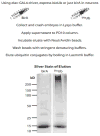Deciphering tissue-specific ubiquitylation by mass spectrometry
- PMID: 22350876
- PMCID: PMC3475722
- DOI: 10.1007/978-1-61779-474-2_3
Deciphering tissue-specific ubiquitylation by mass spectrometry
Abstract
Protein ubiquitylation is a highly conserved, central mechanism to regulate cellular events in all eukaryotes, such as proteasomal degradation, protein trafficking, DNA repair, synaptic plasticity, and immune response. The consequence of protein ubiquitylation is modulated by the structure of ubiquitin (Ub) moiety attached on the substrates, including ubiquitin monomer and diverse polyubiquitin chains with different linkages (N-terminus, K6, K11, K27, K29, K33, K48, and K63). The development of ubiquitin-enrichment strategies coupled with sensitive mass spectrometry enables direct analysis of ubiquitylated proteins in cells, providing an invaluable tool for ubiquitin research. In this chapter, we describe recent technology updates for analyzing tissue-specific ubiquitin conjugates in transgenic models, as well as targeted proteomics methods for quantifying different polyubiquitin chain linkages in any type of -samples, including human tissues.
Figures



References
-
- Ciechanover A. Proteolysis: from the lysosome to ubiquitin and the proteasome. Nat Rev Mol Cell Biol. 2005;6:79–87. - PubMed
-
- Ciechanover A, Ben-Saadon R. N-terminal ubiquitination: more protein substrates join in. Trends in cell biology. 2004;14:103–106. - PubMed
-
- Cadwell K, Coscoy L. Ubiquitination on nonlysine residues by a viral E3 ubiquitin ligase. Science (New York, NY. 2005;309:127–130. - PubMed
-
- Peng J, Schwartz D, Elias JE, et al. A proteomics approach to understanding protein ubiquitination. Nat Biotechnol. 2003;21:921–926. - PubMed
Publication types
MeSH terms
Substances
Grants and funding
LinkOut - more resources
Full Text Sources

